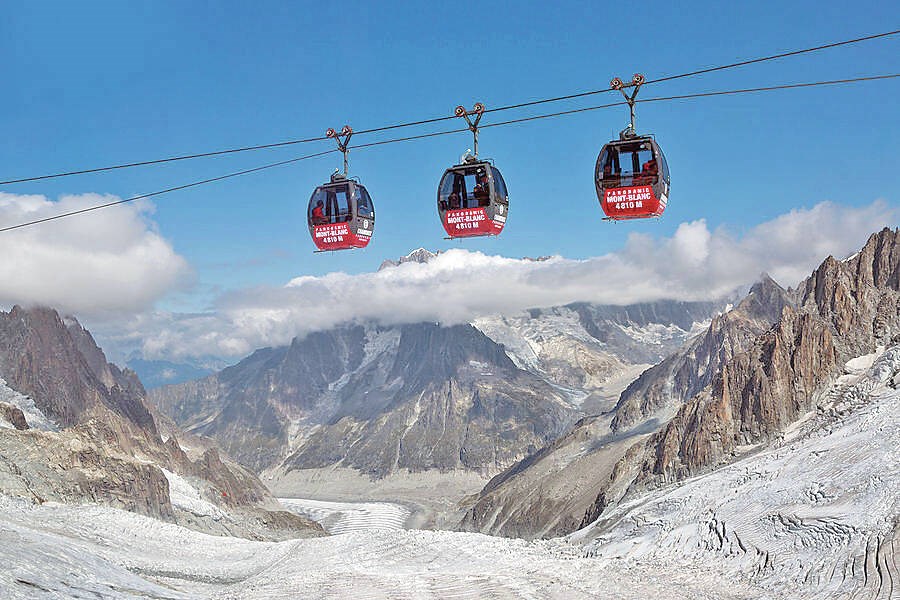Imagine you and your favourite travel partner dangling in your own private little gondola, gliding silently for 40 minutes as you float above the crags and crevasses of the vast Géant Glacier.
On your right is the pillowy summit of Mont Blanc — the tallest Alp of them all. On your left are jagged rocks called dents (teeth) — each famous among the world’s best rock climbers. You’re in the region where Switzerland, Italy and France come together to high-five the sky. As you hover in the rare air, open the window. Notice the silence. Explore every corner of your view as you enjoy the ultimate Alpine joyride.
The ride is also Europe’s most thrilling border crossing. The four-seater Panoramic Mont Blanc télécabines sail above a sea of snow, ice and rocks on a cable that stretches across five kilometres with no solid pylon. (It’s propped by a “suspended pylon,” a line stretched between two peaks 400 metres apart.) On one end of the gondola’s route: the jagged crag of France’s Aiguille du Midi (3,842 metres); on the other, Italy’s Pointe Helbronner (3,462 metres).
While you can reach this glacial dream world from a cable car up the Italian side of the Mont Blanc massif, I’d start in the French resort town of Chamonix, one of Europe’s best launchpads for mountain worshippers.
The Aiguille du Midi cable car, which zips you in two stages between the centre of Chamonix and the dizzying tip of this rock needle — literally miles above the valley floor — is among Europe’s highest and most spectacular. The ride alone makes the Aiguille du Midi worth a visit, even if you don’t hop one of the little red gondolas to Italy from here (they run only in summer, usually from late June until early September, and close down in the early afternoon).
If the weather is clear, ignore the cable car’s steep price. To beat the crowds and clouds, ride the lift (up and down) as early as you can. In summer, leave no later than 8 to avoid major delays. (While you can reserve ahead for a later time, sights and trails get busier the later you go.)
No matter when you go, bring water, sunglasses, sunscreen and plenty of layers — up on top, even sunshine is cold.
The téléphérique car fits dozens of people. As you pile in, try to grab a window spot, especially if you’re shorter than average (you’ll be packed in like sardines). With its scratched-up windows, you can imagine the car filled with stylish European skiers. Outside ski season, it’s a mix of tourists, ruddy hikers, and — especially on the earliest departures — serious mountaineers hefting ropes and crampons.
Chamonix shrinks as trees fly by, soon replaced by whizzing rocks, ice and snow. As you step out of the cable car onto the Aiguille du Midi, it’s immediately apparent that you’re high in the sky.
Consider reapplying your sunscreen, and give yourself a few minutes to acclimate. Fun things can happen on top if you’re not too winded to join in the goofiness that takes over when everyone around you is a little short on oxygen.
From the lofty lookout, the Alps spread out before you. In the distance is the bent little Matterhorn (look for its French name, “Cervin,” on plaques labelling notable peaks). You can almost reach out and pat the head of Mont Blanc — at 4,809 metres, it’s the Alps’ highest point. Telescopes let you spot mountain climbers; more than 2,000 scale this mountain each year.
On your way back down, allow time to linger at the Plan de l’Aiguille, the halfway point between Chamonix and the Aiguille du Midi (where you switch cable cars). Frolic among the glacier-scraped landscape, and consider walking 15 minutes down to the cozy and cliff-hanging Refuge du Plan de l’Aiguille for a reasonably priced meal with a massive view. It’s also the start of a spectacular (and strenuous) three-hour hike across the mountainside to the Mer de Glace glacier. From there you can catch a cogwheel train back down to Chamonix.
Several other breathtaking hikes and cable-car rides lie just above Chamonix.
The high-altitude hillsides hovering right above Chamonix are a world of pristine lakes, great views of the Mont Blanc range, and pockets of wildflowers — all easily reached by cable car or gondola. The three-hour traverse between two lift stations — La Flégère and Planpraz — along the Gran Balcon Sud, across the valley from the Aiguille du Midi, is one of my favorites.
Overhead, hang-gliders lunge off the cliff from the Brévent cable-car station. Watching these daredevils fill the valley like spaced-out butterflies is a thrilling spectator sport. (The ride up above Planpraz to the Brévent peak is worthwhile even for non-jumpers and non-hikers, and is hardly redundant with an Aiguille du Midi visit.) Perhaps the valley’s best hike — two hours each way to peak-framed Lac Blanc — starts from the top of a lift on one end of the Grand Balcon Sud hike (hardy hikers who get an early start can do both in one day).
Chamonix, a convenient train ride from Paris or Nice, is packed in July and August, and during ski season, but it’s plenty peaceful the rest of the year. The town is a delight to stroll, and has an efficient tourist information centre and plenty of affordable accommodations. If you like the Alps, you’ll love Chamonix, where hikers and non-hikers alike can enjoy some of the world’s most unforgettable mountain vistas — with a French accent.
This article is used with the permission of Rick Steves’ Europe (www.ricksteves.com). Rick Steves writes European guidebooks, hosts travel shows on public TV and radio, and organizes European tours.



